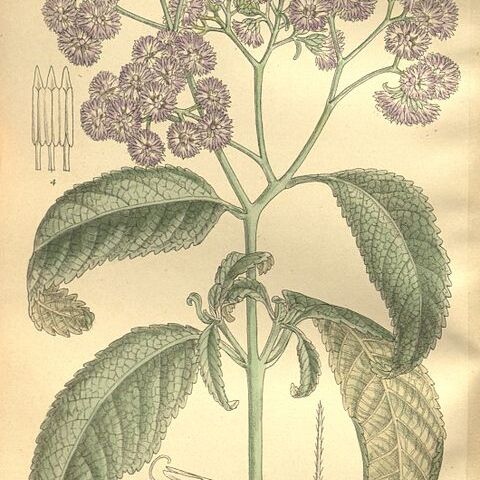Annual or short-lived perennial herbs with striate, ±cylindrical stems. Leaves alternate, rarely proximally opposite, usually subsessile, ovate to linear-lanceolate, subentire to serrate or dentate, mostly acute, with simple multicellular and globose glandular hairs. Capitula homogamous, small, shortly pedunculate, borne in a lax corymb or sometimes in terminal simple or compound cymes. Involucral bracts (2–) 3–4-seriate, imbricate, scarious-margined; receptacle flat or slightly convex, epaleate. Florets strongly exserted from involucre, white, pink or purplish; corolla tube short, glandular, distally expanding gradually into a narrowly campanulate, 5-lobed limb; lobes deltoid, with glabrous apices; anthers included or slightly exserted, with short basal auricles, and ovate-lanceolate terminal appendages; style without nodes below hairy branches. Achenes ±turbinate or obconical, (2–) 4–6-ribbed, glandular in furrows, truncate, apically callose-ringed. Pappus absent.
Achenes ± equalling the involucre in length, subcylindric to turbinate or tapering obpyramidal, strongly 2–6-ribbed, the ribs confluent with a pale apical rim about a ± cup-shaped depression, or apical rim-tissue expanded laterally and the achene apex truncate with a prominent lateral edge, the faces between the ribs ± flat with few to numerous unicellular glandular trichomes.
Florets 5–100 per capitulum; corollas purple, mauve, pink or whitish in upper part, limb regularly deeply 5-lobed, ± funnel-shaped and tapering into a short tube below, or limb subcylindric and ± abruptly contracted into a short tubular lower part, glandular, lobes without apical hairs.
Leaves alternate, sometimes opposite on the lower stem, subsessile (shortly petiolate in some Asian species), broadly-to linear-lanceolate, lamina pubescent to glabrescent, glandular-punctate.
Annual or short-lived perennial herbs with branching erect or decumbent stems, or stems somewhat strict; sometimes rhizomatous.
Capitula homogamous, small or very small, numerous, corymbiformly cymose sometimes subscorpioidly cymose.
Vegetative indumentum of short-stalked flagelliform hairs, or hairs short-stalked ± 1-armed T-shaped.
Stems ribbed, leafy, often becoming woody below and with a pith in the upper part.
Anthers with an apical ovate-lanceolate appendage and short obtuse basal auricles.
Pappus absent, though apical rim sometimes produced into a pappus-like structure.
Involucres short, campanulate, cyathiform or subglobose; phyllaries imbricate.
Style arms stout, subulate, hairy.
Receptacle flat, naked.

